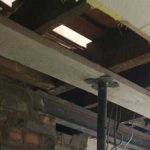A sagging ceiling can be very concerning, and this is with good reason. In the worst-case scenario this could result in a collapsed ceiling.
If a ceiling is sagging, or if it has already collapsed, this could be covered by your insurance. However, different policies will have different rules. Also, it will only be considered a valid claim under certain circumstances.
For example, if your ceiling is sagging due to general wear and tear, this would usually not be covered by your insurance. The insurer would probably say this is a maintenance issue. Therefore, it is the responsibility of the homeowner.

This could cover a wide variety of circumstances, for example:
- Rot caused by prolonged damp conditions
- Woodworm or other types of wood burrowing insects
- Movement and settlement in the property
- Age causing rust and deterioration of fixings.
- Poor construction and inadequate support for the load of the floor above.
If on the other hand, your ceiling is sagging due to a one-off event, such as a serious leak or burst pipe, then this is much more likely to be covered.
Is a sagging lathe and plaster ceiling covered by insurance.
Sagging is very common in old lathe and plaster ceilings. Over the years, this type of plaster tends to bulge and sag. This happens when the lime plaster breaks away from the timber lathe. It can be caused by moisture over prolonged periods. Or just general wear and tear.
Often these ceilings have been up for decades. In some cases over a century and they are quite heavy. They are constructed with timber lats which are fixed to the joists. These are then covered with a lime plaster, which will often contain horsehair.
If the plaster comes away from the lats, it is often only the horsehair holding it in place. After this, the ceiling will start to sag and crack, and eventually, there is a good chance parts of it will collapse.
If this does happen, it is very unlikely it would be covered under any type of insurable event, or even accidental damage.
However, if the ceiling came down as a direct result of serious water damage, or any other unavoidable one-off event, there is a good chance of you being covered.
If a collapse is caused by general wear and tear, or an issue that developed over time, then it’s probably not going to result in a successful claim.
With that said, if you have accidental damage cover and contents cover, this might mean you are covered for things like damage to decoration and personal items.
Again, this will all be very dependent on your individual policy.
Sagging plasterboard ceilings
A common reason for plasterboards sagging is that the fixings have pulled through the board. This could happen for a variety of reasons. It is very common when nails have been used to fit the plasterboards.
Clout nails are nowhere near as good as modern drywall screws, and it is quite common that these will pull out under the weight of the boards.
Back between the 70’s and the late 80’s this was the standard way to fit a plasterboard ceiling. Therefore it is not uncommon to be faced with this problem.
Something like this would not be covered under your insurance, even if it collapsed.
The good news is, if you do have a sagging plasterboard ceiling and there are no obvious issues with the plasterboard, they can easily be fixed back up securely with screws.
Prevention is better than the cure
As a general rule, if you do notice a sagging ceiling, you should try to get it fixed back up to the joists as soon as possible. Whether this is old lathe and plaster or a modern plasterboard ceiling, it will be much cheaper to get it fixed early.
If you do leave it and it does collapse, the mess, damage, and potential injury it causes, could be significant.
If this does happen and your insurance doesn’t cover it, you will be paying out much more to rectify all the damage that has been caused.
Even if there was an insurable event, such as something that caused serious water damage. You should still aim to get sagging ceilings fixed before they collapse. This will increase your chance of a successful claim, as the damage was unavoidable, and the work has been carried out quickly to reduce damage.
If you leave the ceiling sagging for a significant amount of time before it eventually collapses, this could go against you.
An insurer could argue that you knew there was an issue and failed to fix it.
Conclusion
A sagging ceiling can sometimes be covered by insurance. However, most policies will only cover you for some type of significant event that caused the damage. If this is something related to the age of the ceiling, wear and tear, or poor installation, it is far less likely that you will be able to claim.
Please note, we are not insurance experts here at The DIY Fix, the information in this article is based on our own experience and anecdotal information.
For specific details on your own home insurance, you should read your policy, or contact your insurance provider.




